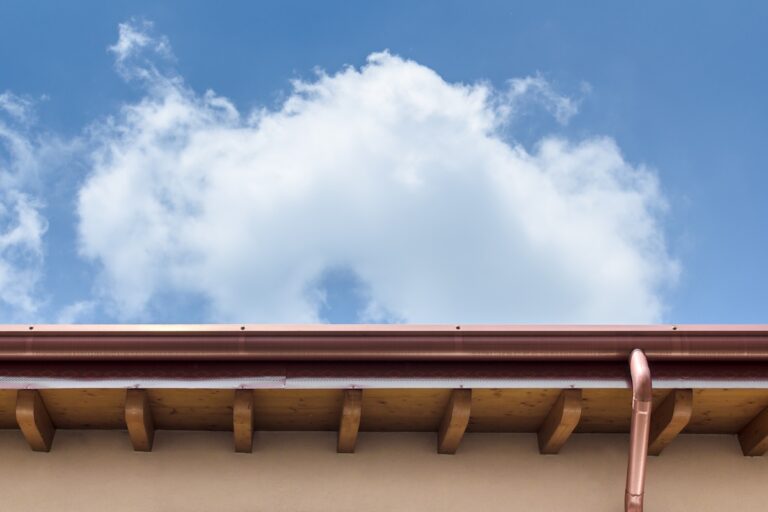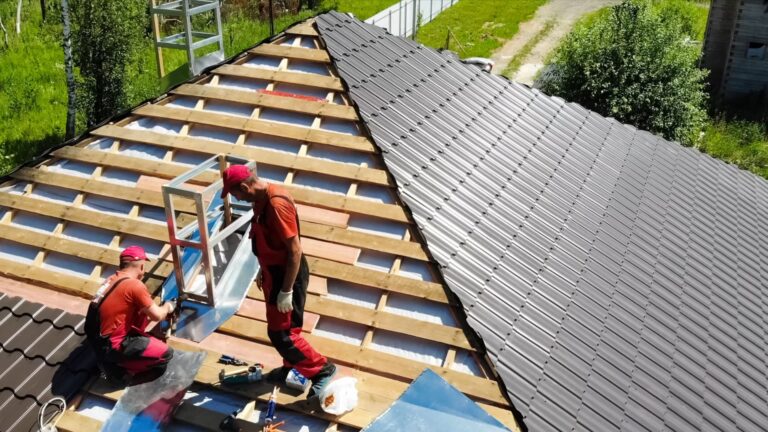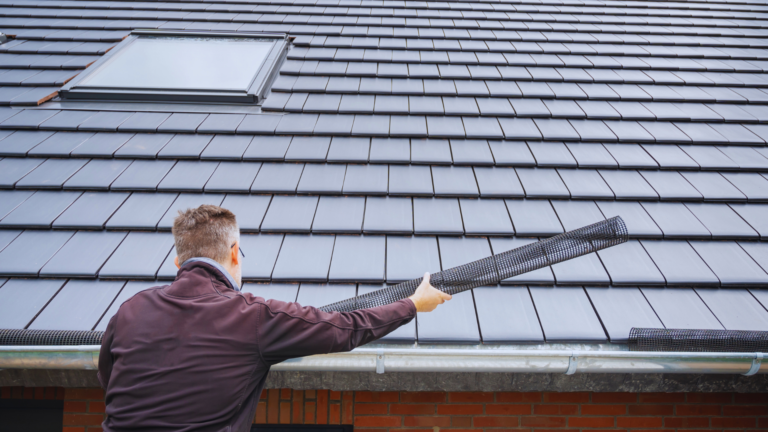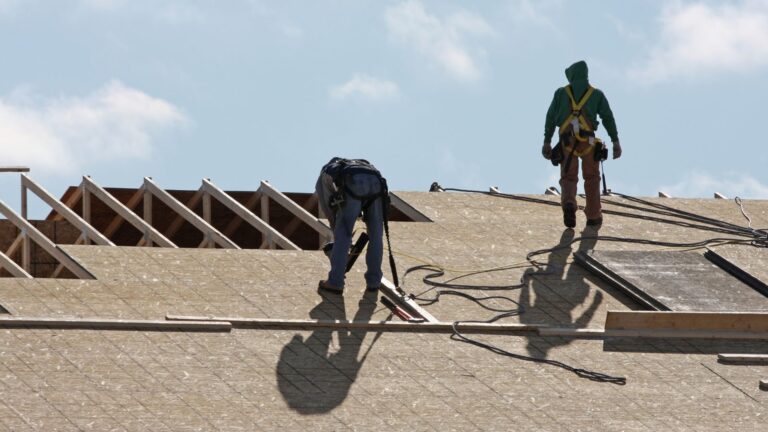Gutter guards are protective covers or filters installed over gutters to prevent leaves, twigs, pine needles, and other debris from clogging the system. They come in various types—such as mesh, micro-mesh, foam, and reverse curve—each designed to let water flow through while blocking unwanted buildup. By keeping gutters clear, these guards help maintain proper water drainage from the roof and away from the home’s foundation.
For homeowners, investing in a gutter protection system is a smart preventative measure. Clogged gutters can lead to serious issues like water overflow, roof leaks, mold growth, and foundation damage. Gutter Guard Installation reduces frequent cleaning and minimizes long-term maintenance costs. In areas with heavy foliage or frequent storms, they provide peace of mind and add value to your property by protecting critical structural components of the home.
Table of Contents
Why Gutter Guards Are Essential
If you’ve ever dealt with clogged gutters and messy water overflow, you know how quickly it can turn into a bigger headache. Gutter guards are a smart solution that helps keep leaves, twigs, and other debris out of your gutters, allowing rainwater to flow smoothly where it should. By preventing blockages, gutter guards help you avoid water damage to your roof, siding, and even your landscaping—protecting your home from costly repairs down the road.
Nobody enjoys the hassle (or expense) of constant gutter cleaning. Without protection, gutters often need to be cleared several times a year—especially after heavy storms or during the fall. With gutter guards installed, you can say goodbye to those frequent cleanings and expensive service calls. They dramatically cut down on the debris buildup, helping you save time, effort, and money while keeping your home looking great.
Beyond just convenience, gutter guards provide serious protection for your roof and foundation. When gutters overflow, water can seep into your roofline or pool around your foundation, leading to leaks, cracks, and structural damage. Gutter guards keep water flowing safely away from your home, helping you maintain a strong, healthy structure and giving you peace of mind, no matter the season.
Types of Gutter Guards
When it comes to protecting your home from water damage and minimizing gutter maintenance, choosing the right type of gutter guard is essential. Each option has unique features, advantages, and potential drawbacks. Here’s an in-depth look at the most common types of gutter guards:
Mesh Gutter Guards
Mesh gutter guards are made from metal or plastic screens with small holes. They are installed over the top of gutters and are designed to block larger debris, such as leaves, twigs, and seed pods while allowing rainwater to flow through.
Pros:
- Affordable and widely available.
- Easy DIY installation for many homeowners.
- Effective at keeping out larger debris.
Cons:
- Fine debris like pine needles or shingle grit can still pass through.
- Requires occasional cleaning to prevent buildup on the mesh surface.
- Lower-quality materials may bend or corrode over time.
Best for: Homes surrounded by trees that shed larger leaves rather than fine needles.
Micro-Mesh Gutter Guards
Micro-mesh guards are an upgraded version of standard mesh guards. They feature an ultra-fine mesh (often stainless steel) capable of blocking even the smallest debris, such as pollen, dirt, and roof grit.
Pros:
- Superior protection against tiny debris and insect nests.
- Highly durable materials that resist rust and corrosion.
- Low maintenance once properly installed.
Cons:
- Higher upfront cost compared to other types.
- Professional installation is often recommended for optimal performance.
- Heavy debris buildup can sometimes affect water flow if not occasionally rinsed.
Best for: Homes near pine trees, or in regions with heavy rain and fine debris.
Foam Gutter Guards
Foam gutter guards are spongy inserts that fit directly into the gutter channel, allowing water to pass through while blocking debris on the surface.
Pros:
- Very affordable initial cost.
- Simple DIY installation; no tools required.
Lightweight and easy to replace if needed.
Cons:
- Foam can degrade, warp, or promote mold and mildew over time.
- May become clogged with fine debris, reducing water flow.
- Not as durable as metal or mesh options, often needing replacement within a few years.
Best for: Temporary or budget-friendly solutions in low-debris areas.
Brush Gutter Guards
Brush guards look like oversized, cylindrical brushes that sit inside your gutters. They allow rainwater to flow freely while trapping debris on top of and within the bristles.
Pros:
- Very easy to install—just place them into the gutter.
- No special tools or expertise required.
- Affordable and reusable after cleaning.
Cons:
- Debris can get tangled in the bristles, requiring frequent maintenance.
- In heavy storms, debris buildup can cause overflow.
- May not be as effective against fine debris like pine needles.
Best for: Homeowners seeking a quick, low-cost, temporary solution.
Reverse Curve Gutter Guards
Reverse curve guards use the principle of surface tension to guide water into the gutter while encouraging leaves and other debris to fall off the edge. These guards typically have a solid top with a curved lip at the edge.
Pros:
- Highly effective at keeping gutters free of leaves and larger debris.
- Minimal maintenance once properly installed.
- Long lifespan with quality materials.
Cons:
- More visible from the ground and can alter the roofline appearance.
- Higher upfront installation cost.
- May not perform optimally in extremely heavy rain, where water can overshoot the curve.
Best for: Homeowners seeking a long-term, low-maintenance gutter protection system.
Integrated Gutter Guard Systems (for Seamless Gutters)
Integrated systems combine the gutter and guard into a single, seamless unit. These are custom-built and installed together, offering a sleek, durable, and efficient solution.
Pros:
- Excellent curb appeal; blends seamlessly with the roofline.
- Maximum durability and effectiveness against all types of debris.
- Often come with extended warranties from installers.
Cons:
- Highest upfront cost compared to add-on systems.
- Requires professional installation; not a DIY option.
- Repairs can be more complex if damage occurs.
Best for: New home builds or full gutter system replacements, where quality and appearance are top priorities.
How to Choose the Best Gutter Guard for Your Home
Choosing the right gutter guard starts with understanding the specific needs of your home. Key factors like your roof type, local weather conditions, and the amount of tree coverage around your property play a major role. For instance, homes with metal or steeply pitched roofs may require specially designed guards to handle faster water flow. In regions with heavy rainfall, a system that offers excellent water filtration without clogging is essential. Additionally, if your home is surrounded by pine trees or trees that shed small debris, you’ll benefit more from micro-mesh guards that can block even the tiniest particles. Assessing your environment carefully ensures you select a gutter guard that performs well throughout the seasons and minimizes maintenance.
Material choice is equally important when comparing gutter guards. Aluminum and stainless steel options are known for their durability and resistance to rust, making them ideal for long-term protection, especially in harsh climates. Stainless steel micro-mesh guards, while typically more expensive, provide superior filtration and longevity. On the other hand, plastic or vinyl guards are more affordable but may crack, warp, or deteriorate faster under intense sun or freezing temperatures. Another crucial consideration is compatibility with your existing gutter system. Some guards are designed to fit traditional open gutters, while others work better with seamless systems. Ensuring a good fit will maximize the efficiency of the gutter guard and prevent costly issues like leaks or improper water flow.
Gutter Guard Installation Process
DIY Gutter Guard Installation: Tools and Safety Tips
- Essential Tools: Ladder, work gloves, safety goggles, drill, screwdriver, tin snips (for trimming), and measuring tape.
- Safety First: Always use a sturdy, level ladder on solid ground; consider using a ladder stabilizer.
- Work with a Partner: Having someone hold the ladder or pass tools makes the job safer and easier.
- Clean the Gutters First: Remove all debris and rinse out the gutters to ensure proper guard installation.
- Wear Protective Gear: Gloves protect your hands from sharp metal edges; goggles shield your eyes from falling debris.
Professional Gutter Guard Installation: What to Expect
- Initial Inspection: A professional will assess your roof, existing gutters, and specific needs before recommending the best guard type.
- Custom Fitting: Guards are often cut and adjusted on-site to fit your gutter system perfectly.
- Installation: Professionals secure the guards using clips, screws, or adhesives, ensuring a snug, durable fit.
- Cleanup: All debris from cleaning and installation is removed, leaving your property tidy.
- Warranty and Support: Most professional installations come with a product and workmanship warranty for peace of mind.
Step-by-Step Installation Guide
- Step 1: Clean the gutters thoroughly to remove leaves, twigs, and dirt.
- Step 2: Measure your gutters to determine how much material you’ll need.
- Step 3: Cut the gutter guards to size, using tin snips or scissors, depending on the material.
- Step 4: Attach the guards according to manufacturer instructions—this could involve snapping them in, screwing them down, or sliding them under the shingles.
- Step 5: Secure the guards tightly and check for any gaps where debris could still enter.
- Step 6: Test the system by spraying water on the roof to ensure proper flow and drainage.
- Step 7: Perform a final inspection to make sure everything is secure and properly aligned.
Cost of Gutter Guard Installation
The cost of gutter guard installation can vary widely depending on the type of guard you choose, with average prices ranging from $3 to $10 per linear foot for materials alone. Foam and brush gutter guards are typically the most affordable, while micro-mesh and professionally installed reverse curve systems tend to be on the higher end. Several factors influence the pricing, including the size and height of your home, the condition of your existing gutters, the complexity of the installation, and whether repairs or custom fittings are needed. While the initial investment may seem high, installing quality gutter guards offers strong long-term savings by reducing frequent cleanings, preventing costly water damage, and extending the lifespan of your gutters. Over time, the return on investment (ROI) becomes clear, as homeowners save both money and time while enjoying better protection for their property.
Common Installation Mistakes to Avoid
One of the most common mistakes during gutter guard installation is using the wrong size or choosing a poor fit for your existing gutters. Gutter guards that are too small or improperly cut can leave gaps, allowing debris to enter and defeat the purpose of the system. It’s essential to measure carefully and ensure the guards match the exact width and shape of your gutters for maximum effectiveness.
Another frequent issue is poor attachment and sealing. If the guards aren’t securely fastened, they can shift, sag, or even detach during heavy rain or strong winds. Inadequate sealing can also lead to water leakage, causing damage to the fascia, siding, and foundation. Using the correct fasteners and following the manufacturer’s guidelines ensures a long-lasting, secure installation.
Lastly, many DIY installers overlook the importance of considering the roof pitch and natural water flow. Gutter guards must be correctly positioned to handle the volume and speed of rainwater coming off the roof. Improper angle or placement can lead to water overshooting the gutters or pooling, resulting in erosion or water damage. Paying close attention to your roof’s design and how water moves will help create a system that works efficiently in all weather conditions.
Maintenance Tips for Gutter Guards
While Gutter Guard Installation significantly reduces the amount of debris entering your gutters, they still require occasional cleaning to maintain peak performance. Generally, it’s recommended to inspect and clean your gutter guards at least twice a year—typically in the spring and fall. If your home is surrounded by heavy tree coverage or located in an area prone to storms, more frequent checks may be necessary. A light rinse with a garden hose and removal of any accumulated debris on top of the guards is usually enough to keep the system flowing freely.
Creating a seasonal inspection checklist can help you stay on top of gutter maintenance without hassle. In spring, check for any damage caused by winter storms, such as dents or dislodged sections. During summer, ensure the guards are still firmly attached and clear of tree sap or seed pods. In the fall, remove any fallen leaves or pine needles, and in winter, inspect for ice buildup or guard warping due to freezing temperatures. Regular seasonal checks ensure your gutter protection system continues working efficiently all year long.
Over time, even high-quality gutter guards can show signs of wear and tear. If you notice sagging, cracks, excessive debris accumulation, rust spots, or sections pulling away from the gutters, it might be time to consider a replacement. Additionally, if you experience persistent overflow issues even after cleaning, it’s a strong indication that your guards are either clogged, damaged, or no longer fitting properly. Replacing worn-out gutter guards promptly helps prevent water damage and keeps your home’s drainage system in top shape.
Frequently Asked Questions
Do Gutter Guards Really Work?
Yes, gutter guards work by significantly reducing the amount of debris that enters your gutters. They help keep leaves, twigs, pine needles, and other debris out, allowing rainwater to flow freely through your gutters. While they don’t eliminate all maintenance, they greatly reduce the frequency of cleaning and prevent clogs that can lead to water damage. However, their effectiveness depends on the type of guard and the conditions around your home.
Are Gutter Guards Worth the Cost?
Yes, gutter guards are often worth the investment. While the initial cost can vary depending on the type of guard you choose, they save you money in the long run by reducing gutter cleaning expenses and preventing costly water damage. By keeping gutters clear, they help maintain the structural integrity of your home, roof, and foundation, which can be far more expensive to repair than the cost of installation.
Can Gutter Guards Handle Heavy Rainfall?
Yes, most modern gutter guards are designed to handle heavy rainfall. However, some types of gutter guards, like reverse curve or micro-mesh systems, are better equipped to deal with large volumes of water without overflowing. If you live in an area prone to heavy rain, choosing a high-quality guard designed for such conditions can ensure your gutters continue to function properly and protect your home from water damage.







